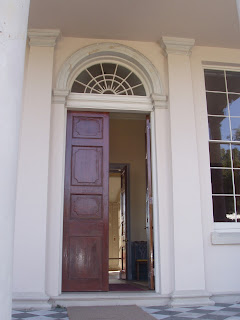The Neoclassical Georgian architectural style of Mount Vernon restored to how it looked in 1799. The main homestead area is skirted by a carriage road with a large bowling green located in the center.
I have had the pleasure of touring George Washington's Mount Vernon five times. Each time was fabulous experience! The house and grounds are so large that on every visit I see something I had not seen before. Theses photo's are from a viset four years ago with a group of tour guides from Historic Homewood house Museum built in Baltimore as a Summer home in 1801. George Washington tuck up residence at Mount Vernon in the mid 18th century, he transformed the Mansion's modest frame exterior, using a process called "rustication." This meant replacing the original plain wooden siding with bevel-edged pine blocks that had been coated with a mixture of paint and sand to give the appearance of stone. The appearance of rustication, creating a rough, unfinished stone-like surface, can be worked on a wooden exterior.
This process became popular in 18th century New England to translate the features of Palladian architecture to the house-carpenter's idiom: in Virginia Monticello and Mount Vernon both made use of this technique. Mount Vernon in particular makes extensive use of feigned rustication and sanded paint and the original finished surfaces of several original planks still survive. Further, Washington added a stunning two-story porch, or "piazza," overlooking the Potomac. Here family and guests would gather in warm weather to enjoy the breeze off the river. Another Washington addition to the house was a cupola -- which served as both a decorative rooftop element and a practical device. With windows open, the cupola helped to cool the house on sultry summer days. After the war, Washington added to the Mansion its final crowning touch -- a gold leaf dove of peace weathervane atop the cupola.
The house was built in phases, as the off-center main door makes evident. The structure once contained the northern portion of the house until it was expanded several times in its history. The house is framed by two covered walkways leading to servants hall on the left and the kitchen to the right. A circular courtyard completes the grand appearance of the house.The main house is located in the center of these support buildings and was once the hub of all the activity at Mount Vernon. The house has two story's with a hipped roof with dormers. In designing his estate, Washington organized the outbuildings, lanes, and gardens in a way that reflects both the practical and aesthetic sides of his nature. From the north to the south are situated the outbuildings, or "dependencies," where the work of the plantation took place. Along the east-west axis are the gardens and pleasure grounds. The work area, although located very near the Mansion, was designed so it would not intrude upon the property's scenic beauty.
Today the Mansion has been restored to its appearance in 1799, the last year of Washington's life.
"I have no objection to any sober or orderly person's gratifying their curiosity in viewing the buildings, Gardens, &ca. about Mount Vernon. ”
—George Washington, letter to William Pearce (November 23, 1794)
Forensic reconstruction of Washington at 19, based on analysis of his clothing and a life mask
The main homestead area is skirted by a carriage road with a large bowling green located in the center.
The exterior of Mount Vernon makes extensive use of feigned wood rustication and sanded paint. The cupola is topped with a dome and a spire with a gilded dove of peace.
Walking down to the Potomac.
Side of Mount Vernon
Looking out over the Potomac.
The Eastern facade, facing the Potomac.
The Eastern facade, facing the Potomac.
The upper garden, located to the north, is bordered by the greenhouse. These gardens grew the household's vegetables, fruit and other perishable items for consumption.
The upper garden, located to the north, is bordered by the greenhouse. These gardens grew the household's vegetables, fruit and other perishable items for consumption.
The upper garden, located to the north, is bordered by the greenhouse.
These gardens grew the household's vegetables, fruit and other perishable items for consumption.
The upper garden, located to the north, is bordered by the greenhouse. These gardens grew the household's vegetables, fruit and other perishable items for consumption.


































































